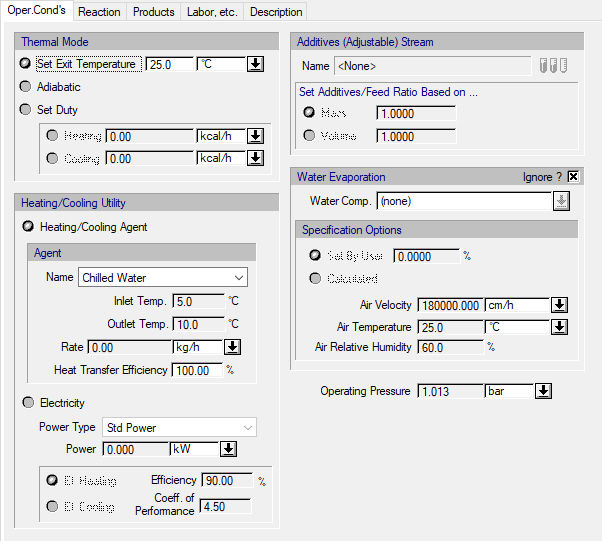

The following table shows a brief description of the variables appearing in this tab. The table also displays their default values and their generally acceptable range:
|
Variable |
Default Value |
Range |
|
|
||
|
◙ ExitTemperature (oC) |
25.0 |
Positive |
|
◙ Heating Duty (kcal/h) |
0.0 |
Positive |
|
◙ Cooling Duty (kcal/h) |
0.0 |
Positive |
|
○ Heat Transfer Agent Name |
<Chilled Water> |
Any Heat Transfer Agent |
|
● Inlet Temp. (oC) |
0.0 |
Positive |
|
● Outlet Temp. (oC) |
0.0 |
Positive |
|
● Rate (kg/h) |
0.0 |
Positive |
|
○ Heat Transfer Efficiency(%) |
100.0 |
[0,100) |
|
○ Power Type |
<Std Power> |
Any Power Type |
|
● Power (for Heating/Cooling) (W) |
0.0 |
Positive |
|
○ Electric Heating Efficiency(%) |
90.0 |
[0,100) |
|
○ Coefficient of Performance |
4.5 |
Positive |
|
● Additives (Adjustable) Stream |
<None> |
Dedicated Input Port |
|
◙ Additives/Feed Ratio Based on Mass |
1.0 |
Positive |
|
◙ Additives/Feed Ratio Based on Volume |
1.0 |
Positive |
|
○ Ignore Water Evaporation? |
Yes |
Yes/No |
|
○ Water Component |
<Water> |
Any Pure Component |
|
○ Water Evaporation (%) |
0.0 |
[0,100) |
|
○ Air Velocity (m/s) |
0.5 |
Positive |
|
○ Air Temp. (oC) |
25.0 |
Positive |
|
○ Air Relative Humidity (%) |
60.0 |
0-100 |
|
● Operating Pressure (atm) |
1.0 |
Positive |
Symbol Key: ○ User-specified value (always input); ● Calculated value (always output); ◙ Sometimes input, sometimes output
The following list describes the available specification choices in this tab; for more details on how these are implemented, see Cont. Stoich. Reaction in an Electrowininng Cell: Modeling Calculations.
•Thermal Mode Options...
Three thermal modes of operation are available: “Set Final Temperature”, “Adiabatic”, and “Set Duty”. If the final temperature is set, then the program will calculate the required heating or cooling duty. If a duty or adiabatic mode is set, then the program will calculate the final temperature.
•Heating/Cooling Utility Options...
If you set the final temperature or the duty, then you must also select the type of utility that is going to be used (heat transfer agent or electricity) in order to achieve the required final temperature or duty. If you choose to use electricity, then you can specify either the efficiency of electric heating (which is used when the electricity is used for heating) or the coefficient of performance (which is used when the electricity is used for cooling).
•Additives Stream Flow Specification Options...
You may either set the ratio of additives mass to feed mass or the ratio of additives volume to feed volume.
•Water Evaporation Options...
You may choose to ignore or consider water evaporation. If you choose to consider water evaporation, then you must select the pure component that represents water in this operation, and you can either set the water evaporation percent directly, or let the program estimate it using a simplified built-in model that is based on the inlet temperature and on the temperature, relative humidity and velocity of surrounding air.